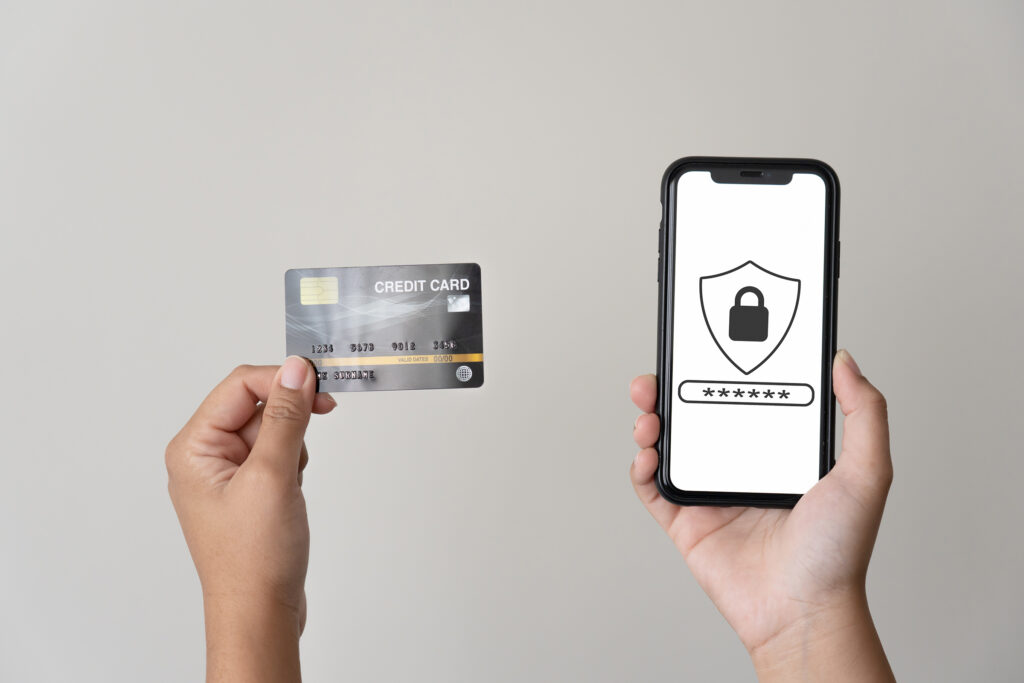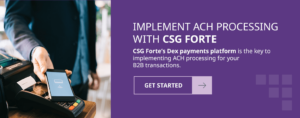How to Make ACH Payments Online: A Complete Guide for Businesses and Consumers
Are you ready to simplify how you move money? Automated Clearing House (ACH) payments make it easy to transfer funds directly between bank accounts—securely, quickly, and without the hassle of paper checks or card fees. The ACH Network backs these transactions, and it’s becoming the go-to choice for businesses and consumers alike.
In this guide, we’ll break down what ACH payments are, why they matter, and how you can start using them with CSG Forte.
How to make an ACH payment online
To make an ACH payment, you typically need the following information:
- Bank account details: You will need the bank account number and the routing number of the account from which the funds will be debited.
- Authorization: Depending on the nature of the ACH payment, you may need the recipient’s authorization to initiate the transaction. This is common for recurring payments or when debiting funds from another individual or business account.
- Payment amount: You must specify the amount of money you wish to transfer through the ACH payment.
- Payment purpose: Indicate the purpose of the transaction, whether it is for a bill payment, payroll, business transaction or another appropriate category.
- Payment processing method: Determine the method through which you will initiate the ACH payment—this can be done through online banking platforms, payment processors or specialized ACH service providers.
- ACH processing information: If you are initiating the ACH payment through a third-party service provider or a payment gateway, you may need to provide additional information such as the provider’s name, account details and any required authentication credentials.
Options for making an ACH payment
When it comes to making ACH payments, there are two primary methods—ACH debit and ACH credit:
- ACH debit: ACH debit involves initiating a payment by granting authorization to a recipient to pull funds from your bank account. This method is commonly used for recurring payments or one-time payments where you provide your bank account information to the recipient. Examples of ACH debit transactions include utility bill payments, mortgage payments and subscription fees.
- ACH credit: ACH credit involves pushing funds from your bank account to the recipient’s bank account. In this case, you are the one initiating the payment and providing the recipient’s bank account information. ACH credit payments are commonly used for various purposes such as payroll direct deposits, vendor payments and tax refunds.
How do I make an ACH payment?
You can send ACH payments online via an ACH debit payment or an ACH credit payment.
How to make an ACH debit payment
Follow these steps regarding how to do an ACH transfer via debit payment:
- Gather recipient information: Collect the necessary recipient information, including the recipient’s name, bank account number and bank routing number.
- Verify sufficient funds: Confirm that you have sufficient funds in your bank account to cover the ACH debit payment amount. Insufficient funds can result in declined transactions and potential fees.
- Choose an ACH debit method: Determine the method you will use to initiate the ACH debit payment—you can do so through online banking, a payment processor or specialized ACH service providers. Check with your bank or chosen service provider to understand the specific process for initiating ACH debit payments.
- Provide authorization details: Depending on your chosen method, you may need to provide the recipient’s bank account and routing numbers, along with the payment amount and any additional information required by the service provider or platform.
- Initiate the payment: Follow the instructions provided by your bank or payment provider to initiate the ACH debit payment. This may involve logging into your online banking account, accessing the payment section and entering the necessary payment details.
- Confirm and review: Before finalizing the transaction, review the payment details to ensure accuracy. Verify the payment amount, recipient information and any additional information required for the transaction.
- Submit the payment: Once you have reviewed and confirmed the payment details, submit the ACH debit payment. The transaction will be processed, and the funds will be electronically debited from your bank account and transferred to the recipient’s account.
- Record and retain documentation: Keep a record of the ACH debit payment, such as transaction confirmations, receipts or any other documentation provided by your bank or payment service provider.
How to make an ACH credit payment
Follow these steps to make an ACH payment via credit:
- Collect recipient information: Obtain the necessary information from the recipient to initiate the ACH credit payment. This data includes the recipient’s name, bank account number and bank routing number.
- Verify your bank’s ACH credit service: Ensure that your bank supports ACH credit transactions. Not all banks offer this service to their customers, so it’s important to confirm beforehand.
- Set up online banking or ACH service: If you haven’t already, enroll in online banking or an ACH service provided by your bank. This measure will allow you to initiate ACH credit payments conveniently.
- Access the payment section: Log in to your online banking account or ACH service provider’s platform and navigate to the payment section or ACH transfer section.
- Provide payment details: Enter the recipient’s bank account number, routing number, payment amount and any additional information required by your bank or service provider. Double-check the accuracy of the information to ensure the funds are directed to the correct account.
- Review and confirm: Review the payment details before finalizing the transaction. Verify the payment amount, recipient information and any additional details you enter.
- Initiate the payment: Once you have confirmed the payment details, submit the ACH credit payment request. Your bank or service provider will process the transaction and transfer the funds from your account to the recipient’s account.
- Retain documentation: Keep documentation of the ACH credit payment for your records.
- Follow up: If necessary, follow up with the recipient to confirm that they have received the ACH credit payment successfully.
ACH payments vs. direct deposits
ACH payments and direct deposits are both electronic methods of transferring funds between bank accounts, but they differ in their purpose and the direction of the transaction.
Direct deposits are a specific type of ACH payment that refers to funds being electronically deposited into a recipient’s bank account, typically for the purpose of receiving income or funds owed. Direct deposits are commonly used for payroll deposits, government benefit payments, tax refunds, pension payments, and other regular or recurring income streams.
Direct deposits are always initiated as ACH credits, with funds pushed into the recipient’s account. The payer, such as an employer or government agency, initiates direct deposits to the recipient’s designated bank account. Recipients often need to provide their bank account and routing numbers to the payer to set up direct deposit.
Key differences between ACH payments and direct deposits include:
- Purpose: ACH payments encompass a broader range of electronic fund transfers, including both payments and receipts, while direct deposits specifically refer to receiving funds into an account.
- Direction: ACH payments can be either ACH debit, which involves pulling funds from the payer’s account, or ACH credit, which involves pushing funds to the recipient’s account, whereas direct deposits are always ACH credit payments.
- Usage: ACH payments are more versatile and can be used for various purposes, while direct deposits are primarily used for recurring income or benefit payments.
Accepting ACH payments from customers
Accepting ACH payments from customers can provide convenience and flexibility for your business. Here’s an overview of the steps involved in setting up and accepting ACH payments:
- Verify ACH payment support: Ensure that your business has the capability to accept ACH payments. Contact your bank or payment service provider to confirm if they offer ACH payment processing services. If not, explore alternative solutions such as third-party payment processors or specialized ACH service providers.
- Obtain authorization: Before initiating ACH payments from customers, you need to obtain proper authorization. This can be done by having customers sign an authorization agreement or including authorization clauses in your terms and conditions.
- Collect customer information: Gather the necessary information from your customers to process ACH payments. This typically includes their bank account number, routing number and authorization to debit their account. Consider using secure methods to collect and store this sensitive information.
- Set up payment processing system: Set up a payment processing system that supports ACH payments. You can complete this step using your bank’s online banking platform, a payment gateway or a specialized ACH payment processing service.
- Integrate the ACH payment option: If you have an online store or payment portal, integrate the ACH payment option to provide customers with the choice to pay via ACH. Work with your web developer or payment service provider to enable ACH as a payment method.
- Educate customers: Clearly communicate to your customers that you accept ACH payments. Update your website, invoices and other communication channels to inform customers of this payment option. Provide instructions on how they can provide their bank account information and authorize ACH payments.
- Process ACH payments: Once customers provide their authorization and necessary payment information, initiate the ACH payments through your chosen payment processing system. Follow the instructions provided by your bank or service provider for initiating ACH debit transactions securely.
- Monitor and reconcile payments: Regularly monitor your ACH payment transactions and reconcile them with your records. Keep track of successful payments, failed transactions and any necessary follow-up actions, such as resolving insufficient funds or other payment issues.
- Ensure security and compliance: Protect customer data and maintain compliance with applicable regulations. Implement security measures such as encryption and access controls to safeguard customer information.
By offering ACH payment options to your customers, you can streamline payment processes, reduce reliance on paper checks and make it easier for people to do business with you.
Choose CSG Forte to start making ACH payments
ACH payments have revolutionized the way businesses and individuals handle their financial transactions. Offering convenience, cost savings and enhanced security, ACH payments have become a preferred method for many individuals and organizations. As technology continues to advance, ACH payments are likely to play an increasingly significant role in our digital economy.
Contact the team at CSG Forte to learn more about how to make an ACH transfer.













